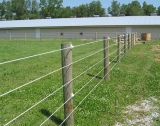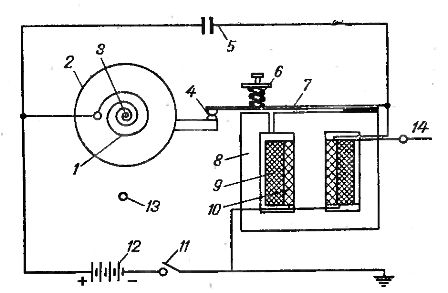How the electric fence works (electric fence) and
 Electric fences (electric shepherds) are installed to fence pastures with driven grazing, to protect crops from animals, hay, etc. The number of wires and the height of their suspension depend on the type of animal. The strength of the electric impulse directed along the wires must be such that the total amount of electricity passing through the animal during the shock does not exceed 3 mA in s.
Electric fences (electric shepherds) are installed to fence pastures with driven grazing, to protect crops from animals, hay, etc. The number of wires and the height of their suspension depend on the type of animal. The strength of the electric impulse directed along the wires must be such that the total amount of electricity passing through the animal during the shock does not exceed 3 mA in s.
An electric fence is made of one or more steel wires with a diameter of 0.9 - 1.2 mm. The conductor is attached to insulators. The main part of the electric fence is a pulser that generates 50 — 60 electric pulses per minute with a voltage of 9 — 12 kV. An animal that touches such a fence receives an electric shock. After 2-3 days after placing the fence, the animals develop a conditioned reflex.
In fig. 1 shows a schematic diagram of an electric fence pulsator. When the circuit breaker 11 is closed, the current circuit is closed through the primary winding of the step-up transformer 8, contacts 4 and the pendulum.The plate 7 attracted to the core pushes the disk of the pendulum 2, which rotates along the axis 3. The pendulum begins to oscillate at a frequency of 50 — 60 times per minute and breaks contacts at this frequency 4.
When the contacts 4 are closed and open, a high voltage pulse is induced in the secondary winding of the transformer, which is fed to the boundary wire. The pulsator is powered by a source of constant voltage 6 — 8 V.
Rice. 1... Structural diagram of the pulsator: 1 — spring, 2 — pendulum disk, 3 — axis, 4 — contact, 5 — capacitor, 6 — spring, 7 — plate, 8 — transformer, 9 — secondary winding, 10 — primary winding, 11 — switch, 12 — battery, 13 — stop, 14 — fence wire.
More economical and efficient pulsators are currently being developed. They have no moving parts because the capacitor discharge through the primary winding is used to generate a pulse in the secondary winding of the transformer. There are pulsators working in the so-called standby mode. These pulsators generate pulses only when the animal touches the boundary wire.
In connection with the expansion of the use of animal grazing with animals and the use of electric fences, studies were carried out that made it possible to clarify the main parameters of pulsators. It was established that the frequency of the voltage pulses on the boundary wires should be within 60 — 120 per minute, and the amplitude should be higher than 2 kV.
The lower limit of the pulse frequency is due to considerations of the efficiency of the fence, and the upper - safety for the animal.Knowing these parameters makes it possible to successfully use electric pulsators to develop reflexes in animals during electrification and automation of basic technological processes, for example, manure removal, milking, etc.

